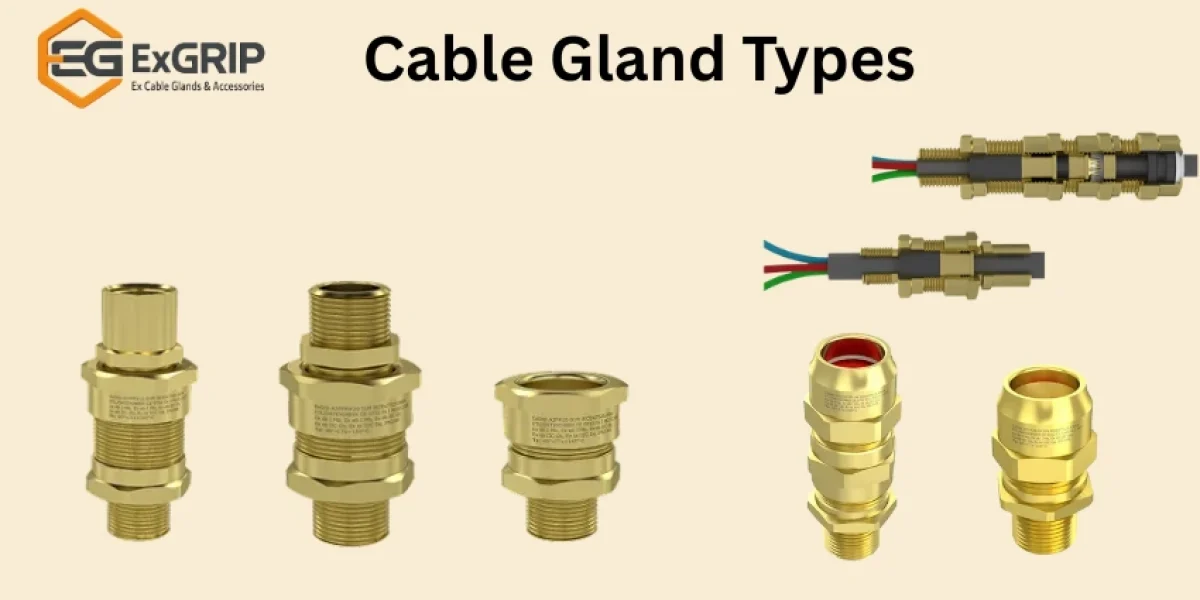In electrical and industrial systems, cable glands are essential components that ensure cables are safely connected to panels, motors, and enclosures. They protect cables from dust, water, vibration, and even explosive gases making them vital for safety and performance.
If you’ve ever wondered what is a cable gland, or which type of cable gland is right for your application, this guide will help you understand every detail from gland types and materials to how to choose the correct cable gland type and size for your setup.
What Is a Cable Gland?
A cable gland (sometimes called a cable connector or fitting) is a mechanical entry device used to attach and secure cables to equipment. It seals the cable entry point, provides strain relief, and maintains the electrical connection’s integrity.
They’re widely used in control panels, junction boxes, and industrial machinery to ensure long-lasting, safe, and neat installations.
In short cable glands protect both your cable and your equipment.
Why the Right Cable Gland Type Matters
Choosing the correct cable gland type and size is crucial for safety and system reliability.
An incorrect size or type may cause:
Loose sealing and water ingress
Cable sheath damage
Loss of mechanical grip
Short circuits or equipment failure
Always check your cable diameter, armor type, and environmental conditions before selection. For quick reference, manufacturers often provide a downloadable cable gland types PDF that matches gland sizes to cable diameters.
Common Electrical Cable Gland Types
Here’s an overview of the main types of cable glands used across industries, classified by compression and application:
Single Compression Cable Glands
A Single Compression Gland is ideal for unarmored, plastic, or rubber-sheathed cables.
It provides basic strain relief and sealing on the outer sheath, suitable for indoor or controlled environments.
These are commonly made from brass or nylon and are simple to install for general applications.
Best For: Control panels, indoor electrical setups, small machines.
Double Compression Cable Glands
Double Compression Glands are designed for armoured or unarmoured cables where higher protection is needed.
They provide two layers of sealing — one on the inner sheath and one on the outer sheath — ensuring a watertight and dustproof connection.
Best For: Industrial, outdoor, and heavy-duty installations.
Example: Power plants, refineries, solar systems.
Unarmored Cable Glands
These glands are used for non-armoured cables that don’t have steel wire or metal protection.
They maintain sealing integrity while allowing flexibility in cable movement.
Lightweight and cost-effective, they are often used for plastic or rubber cables in control and automation applications.
Best For: Electrical panels, control circuits, indoor wiring.
Armoured Cable Glands
Armoured cable glands are built to provide mechanical strength and electrical continuity for steel wire armoured (SWA) cables.
They securely clamp the armor and prevent cable twisting or slippage, ensuring a safe earthing connection.
Best For: Industrial power distribution, construction, and outdoor networks.
Material: Brass, nickel-plated brass, or stainless steel for corrosion resistance.
Waterproof Cable Glands
These glands are engineered for wet or outdoor environments, preventing moisture or dust ingress.
Rated IP66, IP67, or IP68, waterproof glands ensure long-term cable protection in humid or marine areas.
Best For: Solar panels, outdoor lighting, marine, or irrigation systems.
Tip: Always choose glands with verified IP ratings for waterproofing.
EMC Cable Glands
EMC (Electromagnetic Compatibility) glands prevent electrical interference by grounding shielded cables.
They ensure that electromagnetic noise doesn’t affect nearby circuits — crucial in data, automation, and signal systems.
Best For: Automation equipment, data centers, industrial sensors.
Bonus: They enhance signal stability and protect sensitive electronics.
Flexible Hose / Conduit Cable Glands
Also called Field Hose Glands, these are used where cables need flexible protection or pass through conduit pipes.
They are perfect for high-temperature environments or areas requiring vibration protection and mechanical flexibility.
Best For: Machinery with moving parts, automation systems, and conduit-based wiring setups.
Specialized Glands for Hazardous Zones
In explosive or high-risk environments, ATEX cable glands and explosion proof cable glands are mandatory.
These glands are designed to contain flames or explosions that could occur within electrical enclosures, preventing them from spreading to the external atmosphere.
Used In: Oil & gas plants, petrochemical industries, and hazardous area zones (Zone 1 & Zone 2).
Certifications: ATEX, IECEx, and IP68 for complete environmental and explosion safety.
Choosing the Right Cable Gland Type and Size
Here’s how to select the correct gland:
Identify cable type – armoured or unarmoured.
Measure the outer diameter of the cable sheath.
Select the gland material – brass, stainless steel, or nylon.
Match environmental rating – IP66/IP67 for waterproofing, ATEX for hazardous zones.
Refer to a cable gland types PDF from the manufacturer for thread dimensions and sizing.
Why Cable Glands Are So Important
Maintain sealing and strain relief
Prevent moisture, dust, or gas ingress
Ensure electrical continuity for armoured cables
Improve safety and cable longevity
Support compliance with international standards (IP, ATEX, IECEx)
Conclusion & Call-to-Action
Understanding the different cable gland types helps you make informed choices for your electrical or industrial projects.
From single compression to waterproof, armoured, and atex cable glands, each serves a specific role in maintaining safety and performance.
Always verify the cable gland type and size before installation and use reliable electrical cable gland types certified for your environment.
If you’re looking for a quick selection chart, you can download a detailed cable gland types PDF from trusted manufacturers for easy reference.
Choosing the right gland is more than a technical decision it’s a commitment to safety, reliability, and long-term performance.
📩 Talk to our technical team today at Exgrip.com
📞 Or call us directly for quick assistance!
Contact Us:
📞 Phone: +91 9537118899
🌐 Website: www.exgrip.com
📩 Request a Quote: Contact Page
FAQs
What is a cable gland?
A cable gland is a mechanical device used to connect and secure the end of a cable to electrical equipment or enclosures. It provides sealing, strain relief, and protection against dust, moisture, and other environmental factors.
What are the main types of cable glands?
The main cable gland types include single compression, double compression, armoured, unarmoured, waterproof, EMC, and ATEX cable glands. Each type is designed for specific applications and environments.
What is the difference between single and double compression cable glands?
A single compression cable gland is ideal for unarmoured cables and offers basic strain relief. A double compression cable gland provides additional sealing and mechanical strength, making it perfect for armoured or outdoor cables.
How do I choose the right cable gland type and size?
To choose the right cable gland type and size, consider factors such as cable diameter, armor type, operating environment, and IP rating requirements. Always match the gland to the cable’s specifications for a secure fit.
What are ATEX cable glands used for?
ATEX cable glands are designed for use in explosive or hazardous areas, ensuring electrical connections remain safe and spark-free under extreme conditions.
Are waterproof cable glands necessary for outdoor use?
Yes. Waterproof cable glands are essential in outdoor, marine, or humid conditions as they prevent water ingress and maintain electrical safety.
Can I download a cable gland types PDF for reference?
Yes, many manufacturers and suppliers offer a cable gland types PDF that includes detailed specifications, sizing charts, and application guidelines. These resources are helpful for engineers and installers.
If you found this blog helpful, check some of the other blogs below:
- Oil & Gas Industry Cable Glands with –60°C to +200°C Range
- Cable Gland Accessories for Weatherproof Glands
For more insights and updates on web design for small businesses, follow us on Instagram, Facebook, LinkedIn, and Youtube.

